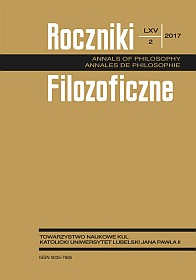The Leibnizian Doctrine of vinculum substantiale and the Problem of Composite Substances
Abstract
This paper is devoted to the late Leibnizian doctrine of vinculum substantiale. In the first section I sketch the old problem of possibility of composite substances. This possibility is refuted on the ground of Monadism (presented in section two). However Leibniz’s correspondence with Des Bosses contains new thoughts concerning composite substances. A vinculum enters the stage as a real unifier, transforming aggregates of monads into genuine substances (section three). In the last section I give a systematic interpretation of a vinculum.
I start with the thesis that every composed thing, which is not a pure plurality of objects, must have two structures: the whole–parts structure and the subject–properties structure. In the case of substances the latter is ontologically prior over the former. A vinculum is a subject-of-properties (accidents) determining such a way of composition which makes a compound entity a true substance. Since Leibniz still thought a vinculum unifies independent (existentially and with regard to activity) substances he was inclined to separate a vinculum from the integrated monads and finally conceived it as an additional relatively independent monad-like substance.
References
Cover, Jan Arthur, and John Hawthorne. 1999. Substance and Individuation in Leibniz. Cambridge: Cambridge University Press.
Ingarden, Roman. 1965. Der Streit um die Existenz der Welt. Band II/1. Tübingen: Max Niemeyer Verlag.
Leibniz, Gottfried Wilhelm. 1989a. “A New System of the Nature and the Communication of Substances, as well as the Union Between the Soul and the Body.” Translated by Leroy E. Loemker. In Gottfried Wilhelm Leibniz. Philosophical Papers and Letters, edited by Leroy E. Loemker, 453–461. Dordrecht, Boston,London: Kluwer.
Leibniz, Gottfried Wilhelm. 1989b. “Monadology.” Translated by Leroy E. Loemker. In Gottfried Wilhelm Leibniz. Philosophical Papers and Letters, edited by Leroy E. Loemker, 643–653. Dordrecht, Boston, London: Kluwer.
Leibniz, Gottfried Wilhelm. 2007. The Leibniz–Des Bosses Correspondence. Translated by Brandon C. Look and Donald Rutherford. New Heaven, London: Yale University Press.
Look, Brandon C. 2000), “Leibniz and the Substance of the Vinculum Substantiale”, Journal of the History of Philosophy 38/2: 203–220.
Look, Brandon C., and Donald Rutherford. 2007. Introduction to Gottfried Wilhelm Leibniz. The Leibniz–Des Bosses Correspondence. Translated by Brandon C. Look and Donald Rutherford, xix-lxxix. New Heaven, London: Yale University Press.
Piwowarczyk, Marek. 2016. “A Leibnizian Inspiration: The Nomological Model of the Subject-Properties Structure.” In “Für unser Glück oder das Glück anderer”: Vorträge des X. Internationalen Leibniz-Kongresses, Hannover, 18.-23. Juli 2016. Band 4, edited by Wenchao Li, 301–311. Hildsheim: Georg Olms Verlag
Rosiak, Marek. 2001. “Własności relacyjne, całości i przedmioty wyższego rzędu [Relational Properties, Wholes and Objects of Higher Order].” Principia, vol. 30: 117-133.
Rosiak, Marek. 2006. “Formal and Existential Analysis of Subject and Properties.” In Essays in Logic and Ontology, edited by Jacek Malinowski and Andrzej Pietruszczak, 285–299. Amsterdam, New York: Rodopi.
Copyright (c) 2017 Roczniki Filozoficzne

This work is licensed under a Creative Commons Attribution-NonCommercial-NoDerivatives 4.0 International License.





